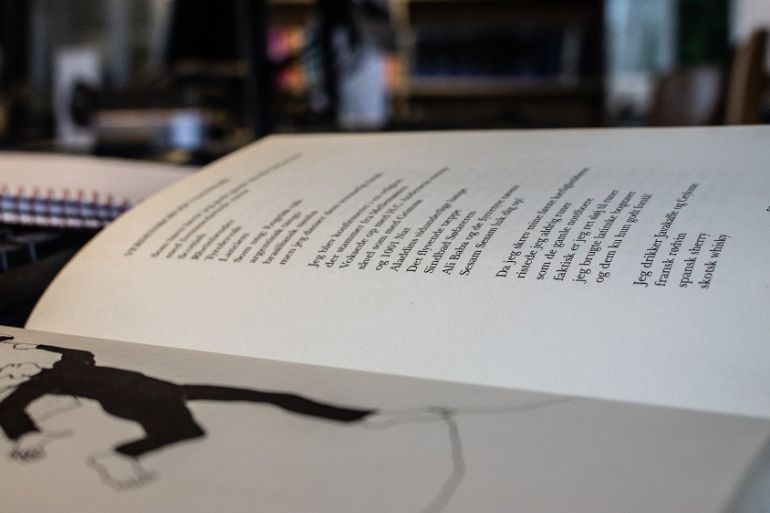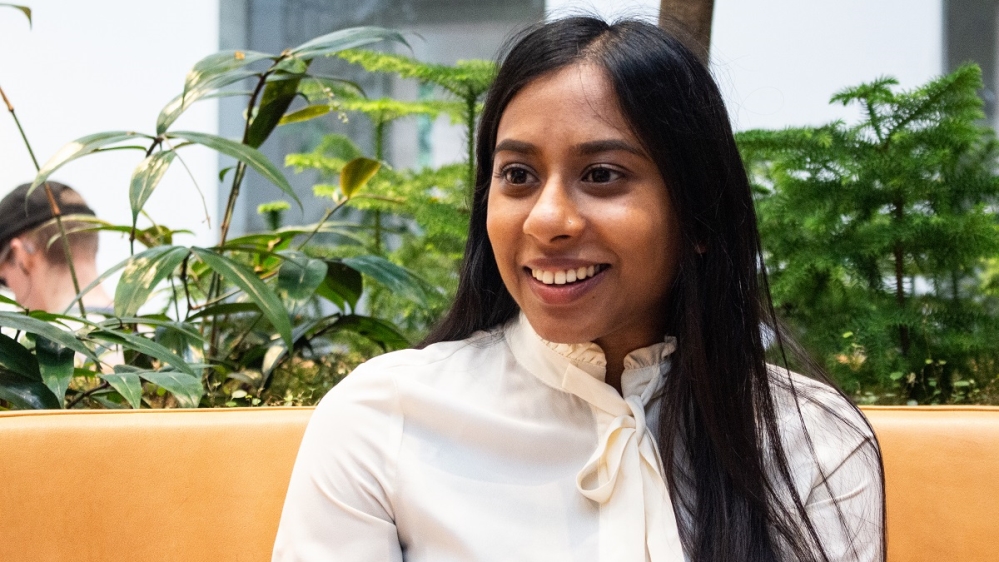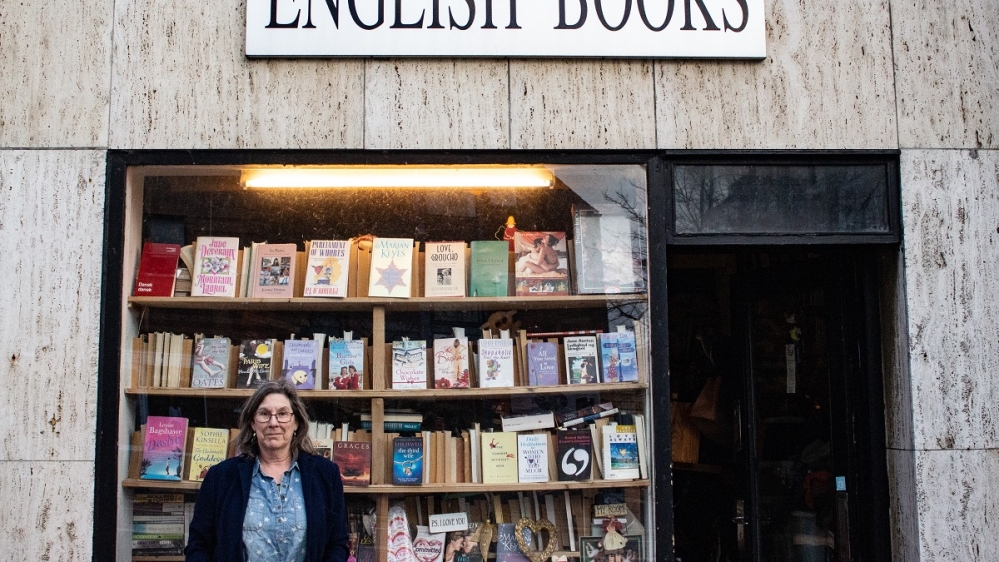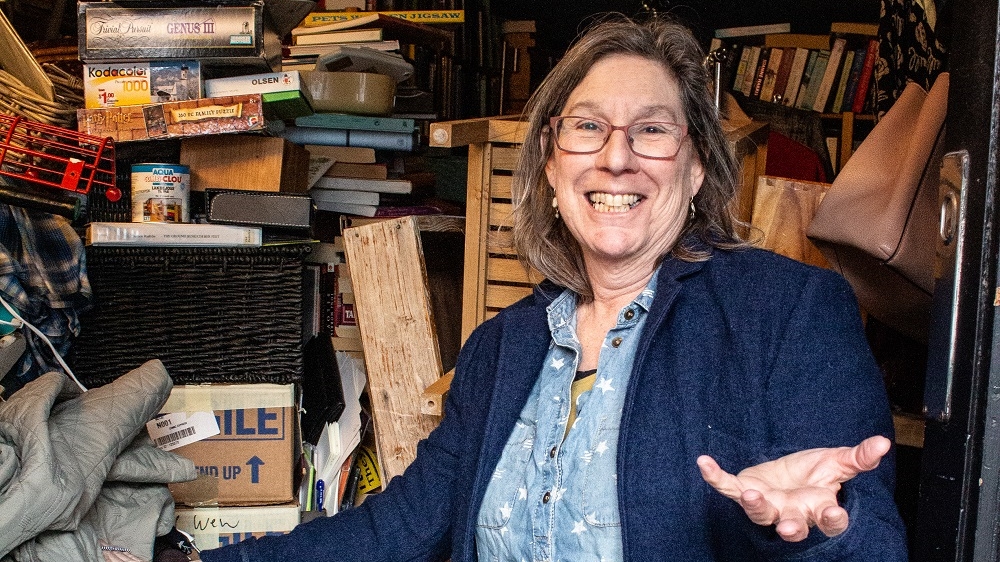What an airline advert revealed about Scandinavian nationalism
When Scandinavian Airlines asked ‘what is truly Scandinavian?’ the answer induced anger and questions about racism.

When the renowned Danish poet, Benny Andersen, published the poem Verdensborger i Danmark, (World Citizen in Denmark) in 1995 there was no outrage.
“The language I sing and speak is woven together by words from all over the world, not just from German, English and French,” wrote the poet, considered one of the country’s most important authors.
Keep reading
list of 4 items‘Feel less and less like playing’: Vinicius Jr in tears over racist abuse
‘Rendered invisible’: A wave of anti-Arab violence tests US hate crime laws
Germany bans far-right Austrian nationalist Martin Sellner from entry
A quarter of a century later – in February this year – an advertisement by Scandinavian Airlines (SAS) with a similar message has drawn fury from Danes, Norwegians and Swedes. The reaction, experts argue, is a symptom of a new surge in nationalistic sentiment across Nordic countries.
The SAS commercial, which was taken down the following day amidst a huge backlash, posed the question: “What is truly Scandinavian?”, followed by the answer: “Absolutely nothing”.
Such was the rage in response, there was even a bomb threat against the headquarters of the advertising company, &Co, in Copenhagen.
What caused such offence? The almost three-minute video set about deconstructing things deemed to be truly Scandinavian – rye bread, interior design, parental leave – by showing that they were all actually brought to Scandinavia from other cultures and then adapted locally. It is what Anderson was saying all those years ago in his nationally-acclaimed poem.
Two days after the commercial aired, the spokesman for the right-wing Danish People’s Party, Soren Espersen, posted on Twitter: “SAS, with its nasty campaign film, spits on everything that is really Norwegian, Swedish and Danish.”
In an interview with the Danish news organisation, Ekstra Bladet, he called on the government – a shareholder in the airline – to intervene in the matter. When Al Jazeera contacted Espersen, he declined to comment.
Denmark was always proud, ‘but in a cosy, cute way’
Beth Merit, 61, is a US national who owns an English-language bookstore in Aarhus, a city on the Jutland peninsula and recently became a Danish citizen after 35 years of living in the country.
For Merit, however, nationalism has long been present in Denmark. “But it was in a cosy, cute way,” she says. “Now it’s more nationalism in anger to protect their way of life, their identity. Nationalism here now is more fear than just pride in their country.”
The fear she refers to is not about violence and hardship, so much as it is about losing identity.
Mette Frost, 48, a masters student at the University of Southern Denmark, living in the countryside in Mid-Jutland, is a proud Dane.
She cites the Danish culture of poetry and music as well as its long-held educational ideals as values to be upheld, but she voices some concern about how nationalism has developed in her country.
She says she wishes people would be more accepting of foreign cultures.
“There are a lot of things that I’m really proud of, but I’m really not proud of the narrow horizon that has slowly been developing in the last 20 years.”
‘Here to steal their wealth’
Amir (who did not want to use his real name) is a 37-year-old wind energy engineer from the Middle East who has been living in Aarhus for the past 18 months.
He says he believes there is a feeling among some Danes that foreigners only come to Denmark to benefit from the welfare system or, as he puts it, to “steal their wealth”.
What has surprised him, he says, is that he has heard younger people repeating these opinions, when he thought it would be restricted to older generations.
Amir sees this attitude reflected in the stance some Danes take towards refugees and asylum seekers, who “tend to be seen as lazy and only seeking to obtain government support without actually performing in society”. This affects him personally, he explains. Because he has the “looks, the name, and even the language of a refugee”; the first impression some people have is that he is one.
As a Muslim, he says he has learned to spot Islamophobia in Denmark. He sees a contradiction between discourse and practice in, for example, the way many Danes are so reserved about their personal space and value their own freedom, while the government enforces handshakes in citizenship ceremonies and prohibits the wearing of face veils – a ban that has been in place since August 2018.
His experience is borne out by the statistics. According to the European Islamophobia report published in 2018, the National Crime Prevention Centre registered 67 reported incidents of religiously motivated hate crimes targeting Muslims in 2017, a record number.
‘It hurts’

Mathuja Mahendrarajh, 23, is Danish although her parents are from Sri Lanka. They fled the Southeast Asian country in the 1980s to escape civil war.
Mahendrarajh, who lives in Aarhus, says she did not find the advertisement offensive and she had expected other Danes to see the funny side as, in her opinion, Danes often use this kind of humour to jest with one another.
But she agrees that her parents’ background may have influenced how she viewed the video.
“I have grown up in an environment where I have always had to incorporate both my Danish culture and my Tamil culture into my lifestyle so I am not 100 percent bonded to one nationality,” she says. “That’s why I’m not that nationalistic compared to a real Dane. I don’t take it that hard.”
But Mahendrarajh, a Masters student in Business at Aarhus University, says she does understand the sentiment the video, which has received more than one million views on YouTube alone, roused in her compatriots.
“We are very proud of our nationalism, of our stuff like rye bread, all these things that are Danish. So if someone tells us it’s not Danish, it hurts us in some way,” she explains.
‘One identity’
Merit, the bookshop owner, senses a feeling among Danes that they must protect their society. “In the United States, we have racism and awful things happening, but there is not one identity. Here there was one identity and that is being challenged,” she says.

Merit explains that she finds it difficult that she is still questioned by Danes about her motives for moving to Denmark 35 years ago. In the past, she says, there was little awareness of the fact that some people do not celebrate Christmas, as is the case for her Jewish family.
Beatrice (who did not want to give her real name) recounts her own experience of racism in Denmark. Walking in the street after a night out at a club with her friends, the 22-year-old African American exchange student who chose Aarhus for her year abroad was caught off guard when a Dane she had just met that night touched her hair, saying: “Oh, so you have African descent.”
On another occasion, she says, Danes from her course discussed using the n-word, arguing that it was not problematic to use it in the context of singing along to songs. When she voiced her discomfort, she says, they rejected her sentiment, leaving her feeling silenced.
But Beatrice points out that even when nothing is said, she can still feel people staring at her at the supermarket, for example. When her mother came to visit her from the US, Beatrice says she also noticed it.
Whitewashing history
Scandinavian countries have received an influx of refugees and migrants in the past few decades. In Denmark, according to data from Statistics Denmark, the national statistics agency, immigrants and their descendants – the term is used to refer to Danes who have either immigrant parents or descendants with other, foreign citizenship – now represent 13.8 percent of the population, up from 9.8 percent in 2010.
In Norway, a country of 5.3 million, the percentage of immigrants or people Norwegian-born to immigrant parents stood at 17.7 percent in 2019, according to the national statistics agency.
In Sweden, which historically has welcomed a larger number of people with foreign backgrounds, foreigners (including immigrants and Swedes born to immigrant parents) represented 24.8 percent of the population in 2019, according to Statistics Sweden.
Scandinavian societies have always envisaged themselves as ethnically and religiously homogeneous, says Sindre Bangstad, a research professor at the Institute for Church, Religion and Worldview Research (KIFO) in Oslo, Norway.
“In the context of Norway, for example, the existence of indigenous people throughout history is suppressed and not taken into account when Norwegians imagine their own societies,” he says.
Similarly, the scholar Henry Minde, at the University of Western Ontario, argues that the period between 1850 and 1980 was marked by a policy of assimilation, often referred to as “norwegianisation” of the Sami minority indigenous people of Norway. As a result, the Sami were pressured by state policy to drop their language and abandon basic cultural values, he writes.
The Sami people define themselves as the indigenous people of the North – original inhabitants of a land that stretches across what today is Norway, Sweden, Finland and Russia. Their total population is estimated to be between 50,000 and 100,000 people, of whom half live in Norway, according to the human rights organisation International Work Group for Indigeous Affairs (IWGIA).
What differentiates them is their language – there are nine different languages spoken by Sami people – and elements of their culture, including long-held traditions such as reindeer herding.
In 1989, the Sami people won the right to establish a Sami parliament through which it deals with the Norwegian government regarding Sami policy.
“This tendency to think of Scandinavian societies as being ethnically, culturally and religiously homogeneous has if anything become more pronounced in the context of a quite significant demographic change,” says Bangstad.

Changing demographics in Denmark have sparked increasingly anti-immigration rhetoric. In June 2019, the left-wing Social Democrats party obtained a majority after forming a coalition with five left-leaning parties in Parliament, with Prime Minister Mette Frederiksen openly campaigning on an anti-immigration agenda.
In an interview with the Financial Times newspaper just before the election in June 2019 the current Danish Minister for Immigration and Integration, Mattias Tesfaye – at the time the immigration spokesman for Frederiksen’s party – declared that to protect the Scandinavian welfare state, “immigration must be controlled”.
‘My profession is a side job’
Charles (who wished to remain anonymous), a 31-year-old black Belgian national, arrived in Denmark seven years ago to pursue a Masters in Architecture. At the time, he already held a Masters degree from his home country. Still, he says he could not find a job in his area after the course ended.
Today, architecture is a side job – one that he balances with driving taxis and operating a moving company.
He says job hunting in Denmark has been an experience marked by racism. Every job he has found has come to him as a result of recommendations by Danish friends – that is, when a Dane has vouched for his qualifications. On one occasion, during a job interview, he says the person interviewing him used the n-word.
In the beginning, Charles says, he tried to make people aware they were being racist. Today, after losing track of the number of times he has experienced discrimination, he feels it is a waste of time.
Tug of war
Norway, argues Bangstad, has been coping positively with the high rate of immigration, something he attributes to the fact that it is a relatively stable, prosperous and well-functioning society. However, he also sees a constant and underlying tug of war between the different perspectives.
“You have this constant pushback and attempts by people in the right-wing to somewhat create and sustain all kinds of privileges and to create and sustain new boundaries and borders,” he says.
In its campaign manifesto, the ruling Conservative Party pledged to adopt a stricter immigration policy. Among its promises, the party said it aimed to introduce restrictions on asylum requests, family reunification and unaccompanied minors seeking refuge in the country.
A report by the European Council on Refugees and Exiles (ECRE) from 2017 found that European states, including Finland, Sweden and Norway, were openly promoting the high numbers of people they were returning to Afghanistan going against humanitarian recommendations not to do this.
“You don’t necessarily have to go to white supremacists and people who subscribe to these ideologies to find defensive attitudes when it comes to the protection of white privileges,” Bangstad explains.
At the start of March, the right-wing Progress Party, which entered the government in 2013 after an invitation from the Conservative Party to form a coalition sent 10 proposals to Parliament to prevent what they said would be a new stream of refugees and immigrants entering Norway. These proposed measures found support from the ruling Conservative Party.
While the reaction to a specific incident like the SAS video might not have an immediate impact, says Bangstad, the damage can build up over time. “These kinds of layers upon layers of reinforcing certain nationalist tendencies, which once is played out over time, in the end, have a cumulative effect.”
Truly Scandinavian?
When she first saw the video, Anne-Kragh Pedersen says she was offended. Pedersen, 51, is a certified French translator based in Aarhus where she has lived for 30 years.
In her opinion, the video targeted national treasures very dear to Danes, such as the rye bread. “I don’t care where it comes from because to me it has a value as something being Danish,” she says.
For Aarhus anthropologist and university professor Peter Hervik, however, defining Danish identity is a problematic endeavour, as Danish culture is a product of globalisation. Therefore, he argues, Danes have come to define themselves in terms of what they are not – instead of what they are.
“Danes are not able to give an exact answer to the question about what Danish values actually are,” he says. “Instead, their answers – according to research throughout the last 25 years – will describe which values they don’t like, and what kind of people they don’t like or maybe even hate.”
In his book, The Annoying Difference, Hervik refers back to the vote on the Maastricht Treaty in 1992, which established the European Union.
At the time, Danes, as citizens of a small affluent country, were faced with the questions of what their language and culture would become in a new Europe where borders disappeared and integration increased.
In a 1992 referendum, the treaty was largely rejected by Danish citizens. After negotiations with the then EU member states, which resulted in four Danish opt-outs, including the right to maintain the Danish crown as its own currency, a referendum held the following year enabled the treaty to be ratified.
In the case of Norway, in a referendum held in 1994, the population rejected EU membership. Today, Norway participates in the EU internal market as a result of the Agreement on the European Economic Area (EEA), but is not a member state.
“By promoting a language, rhetoric and policies against those who are considered unlikeable, Danes create community among themselves,” argues the professor.
The “ghetto plan” is one example of a widely accepted policy targetting a minority group in Denmark. Under a law presented by the previous government, a right-wing coalition with an anti-immigration agenda led by former prime minister Lars Lokke Rasmussen of the Liberal Party, in March 2018, areas in which more than 50 percent of the residents are immigrants or descendants of non-Western immigrants can be designated as ghettos.
The classification of “ghettos” is part of a larger government plan named “One Denmark without a parallel society – no ghettos in 2030”.
Lamies Nassri, 35, a language psychologist who works at the Center for Danish Muslim Relations in Copenhagen, says it is a clear example of discrimination.
“It is blatantly stating that ethnicity is the problem. We are in a situation where politicians are publicly spreading misinformation to the public, creating fear and intolerance among the Danish population so that they can create legislation that will actually in the end forcibly remove people from their own homes.”
Nassri says she was faced with another example of discrimination when she discovered that, despite having been born and raised in Denmark, she is classified within the population statistics as a non-Western descendant because her parents are both from Syria, even though they have Danish citizenship.
Statistics Denmark confirms that if someone is born and raised in Denmark, but has parents who are from a non-Western country, then this person will be classified as a descendant from a non-Western country in statistics (outside of Europe, Canada, the US, Australia and New Zealand).
On more than one occasion, Pricilla Cheung, a 29-year-old Hong Kong-American based in Aarhus, says she has been yelled at by the locals, something she attributes to her being a person of colour.
Once, while waiting for a bus, a Danish woman approached Cheung’s then-boyfriend, a Dane, to warn him that the girl was “dangerous” for him, she says.
‘Mainstream extremism’
When it took down its advertisement, SAS said that while it did not regret the message conveyed, it was not prepared to act as a platform for values that it does not share.
“The pattern in the comments sections and the volume of reactions in SAS’ social media channels suggest that the campaign was subject to an attack,” said the company in a statement published on its website on February 12, two days after the advertisement was first aired.
A report by the Danish broadcaster DR, also published on February 12, identified that in less than a day, more than 20 threads about the airline advertisement were created on 4Chan, an online forum, with far-right and neo-Nazi content.
In some comments, according to the report, users urged harassment against employees of the advertising agency.
Hervik says he believes the reaction to the video came from radical right-wing groups which could be willing to use violence for their cause.
“The radical-right website, 4Chan, the alt-right and the Resistance movement all contributed to these comments with extreme language, demands and encouragement to attack SAS on social media,” says the professor.
But he sounds another important alert: in the current Danish context, the labels “extreme-right” and “far-right” have become unclear.
“These are spatial metaphors and they are deceiving as the whole of Denmark becomes more and more nationalistic. Since the radical right has conquered the political middle in Denmark, those reactions are now a centre-right thing, it’s dominant, it’s most people. It has become what I call mainstream extremism,” argues Hervik.
In 2015, the right-wing Danish People’s Party received over 20 percent of votes in the parliamentary elections, making it the second-biggest party in the country and the largest on the right. In the 2019 elections, however, the party widely lost support, receiving less than 9 percent of votes.
In Nassri’s view, the drop in support for the Danish People’s Party does not translate into less support for right-wing ideology, as she highlights that more parties have surged with the same ideas as the People’s Party.
Instead, it is down to the fact that left-leaning Social Democrats have taken on the right-wing discourse by, for example, supporting and executing the ghetto plan.
According to Hervik, neo-nationalism is the ultimate political weapon to garner support from voters and it operates by appealing to emotions, by raising the threat of an external attack on cultural, ideological, political or military grounds.
Even if one does not subscribe to right-wing ideologies, one will endorse being against a perceived threat. “You cannot meaningfully be against it without being accused of being a traitor,” he says.
For Cheung, the biggest obstacle to addressing growing racism and discrimination in Denmark is the lack of acknowledgement of it by Danes. “When you want to tackle a problem, identifying it has to be the first step. But the thing is here they don’t even use the word ‘racism’ or ‘race’.”